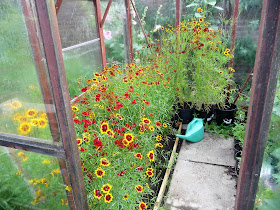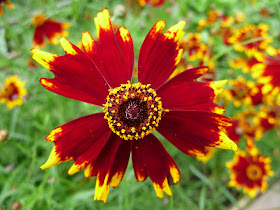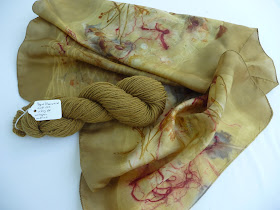I thought coreopsis tinctoria was a bomb proof dye plant to grow. This year, while seeds germinated rapidly indoors in March and the seedlings grew well in an unheated greenhouse, in April they were attacked by thrips and the majority had to be chucked out.
In fear of losing my summer's dyeing, I overcame any ecofriendly scruples and sprayed bug killer everywhere, sowed more seed and transplanted the surviving seedlings into pots and ground inside the greenhouse, not wanting to lose any more in the unpredictable weather. The thrips turned out to be a blessing in disguise, as coreopsis tinctoria has adored extra warmth and protection from wind and rain, flowering weeks earlier than usual and currently, incredibly prolific.
The whole plant is loaded with intense dye colour, even the leaves and stems print clearly, simply from being rolled up in mordanted cloth and simmered in a dye bath. This photo shows a coreopsis tinctoria print on cotton jersey mordanted with aluminium acetate. Actually, I'll show you the back of the T shirt and do a promotion - it will be for sale this weekend along with lots of plant dyed silk scarves and cotton and linen shirts, wool and silk yarns. Do come and see me doing a Rich & Strange stand in the Craft Tent by the castle at the Caerphilly Big Cheese Festival along with my mate BG, who can now be outed online as local artist, Catherine Pyves.
Well, I think 'weed it and reap' is funny.
Although the second sowing of coreopsis tinctoria did give me plenty of plants for the garden, back in my April panic, I also ordered from an online nursery a dozen plug plants of two other varieties, called Sunkiss and Early Sunrise. Rolling up their first flowers in ecobundles made no discernable prints, so I was not optimistic about these plants containing much dye. They are much shorter and sturdier than coreopsis tinctoria and thus, easier meat for the slugs. Most have survived, though I do confine myself to natural control methods for the evil gastropods. Mostly.
 During July these other coreopsis started flowering more heavily, an ideal month for trying them in solar jars.
During July these other coreopsis started flowering more heavily, an ideal month for trying them in solar jars.
While coreopsis tinctoria flowers will flood a jar of water with dark colour within hours (jar on left), these two other varieties of coreopsis (jars on left) took a couple of weeks to leak much colour into the water. Their early flowers are still in those jars with some Beulah fleece, but last week, there were lots of flowers blooming and the jars did look promising.
A mixture of Sunkiss and Early Sunrise weighing 70g were simmered for an hour in a pot, then a 25g skein of alum mordanted wool yarn and 5g silk yarn were simmered for an hour and left overnight. In another pot, 40g of coreopsis tinctoria flowers were given the same simmering and the same weights of wool and silk yarns.
Two weeks ago, I blogged about this year's failures to get the expected orange dye out of coreopsis tinctoria flowers. The results of this dye session proved a nicer surprise. The vivid orange yarn on the left with the golden silk skein came from the Sunkiss and Early Sunrise bath. The more bronze orange on the far right skein of wool came from the coreopsis tinctoria bath and the silk in there had turned a green, not unlike the yarn from the previous coreopsis tinctoria bath which I guessed might have been contaminated with iron. Maybe that green simply comes from having too great a ratio of coreopsis tinctoria to fibre?
Anyway, I kept picking all the Early Sunrise and Sunkiss flowers and dyed another two skeins of wool and silk and then modified their orange colour by heating one briefly in dilute copper solution (middle of photo) and the other dilute iron (left). I'm delighted with the colours and will definitely be saving seeds to sow again next year - only I suppose all three varieties might hybridise and who knows what will happen in my dye baths then?
In fear of losing my summer's dyeing, I overcame any ecofriendly scruples and sprayed bug killer everywhere, sowed more seed and transplanted the surviving seedlings into pots and ground inside the greenhouse, not wanting to lose any more in the unpredictable weather. The thrips turned out to be a blessing in disguise, as coreopsis tinctoria has adored extra warmth and protection from wind and rain, flowering weeks earlier than usual and currently, incredibly prolific.
Well, I think 'weed it and reap' is funny.
Although the second sowing of coreopsis tinctoria did give me plenty of plants for the garden, back in my April panic, I also ordered from an online nursery a dozen plug plants of two other varieties, called Sunkiss and Early Sunrise. Rolling up their first flowers in ecobundles made no discernable prints, so I was not optimistic about these plants containing much dye. They are much shorter and sturdier than coreopsis tinctoria and thus, easier meat for the slugs. Most have survived, though I do confine myself to natural control methods for the evil gastropods. Mostly.
 During July these other coreopsis started flowering more heavily, an ideal month for trying them in solar jars.
During July these other coreopsis started flowering more heavily, an ideal month for trying them in solar jars. While coreopsis tinctoria flowers will flood a jar of water with dark colour within hours (jar on left), these two other varieties of coreopsis (jars on left) took a couple of weeks to leak much colour into the water. Their early flowers are still in those jars with some Beulah fleece, but last week, there were lots of flowers blooming and the jars did look promising.
A mixture of Sunkiss and Early Sunrise weighing 70g were simmered for an hour in a pot, then a 25g skein of alum mordanted wool yarn and 5g silk yarn were simmered for an hour and left overnight. In another pot, 40g of coreopsis tinctoria flowers were given the same simmering and the same weights of wool and silk yarns.
Two weeks ago, I blogged about this year's failures to get the expected orange dye out of coreopsis tinctoria flowers. The results of this dye session proved a nicer surprise. The vivid orange yarn on the left with the golden silk skein came from the Sunkiss and Early Sunrise bath. The more bronze orange on the far right skein of wool came from the coreopsis tinctoria bath and the silk in there had turned a green, not unlike the yarn from the previous coreopsis tinctoria bath which I guessed might have been contaminated with iron. Maybe that green simply comes from having too great a ratio of coreopsis tinctoria to fibre?
Anyway, I kept picking all the Early Sunrise and Sunkiss flowers and dyed another two skeins of wool and silk and then modified their orange colour by heating one briefly in dilute copper solution (middle of photo) and the other dilute iron (left). I'm delighted with the colours and will definitely be saving seeds to sow again next year - only I suppose all three varieties might hybridise and who knows what will happen in my dye baths then?
































